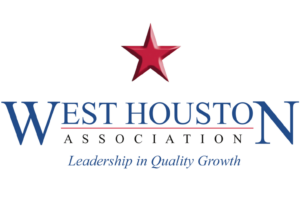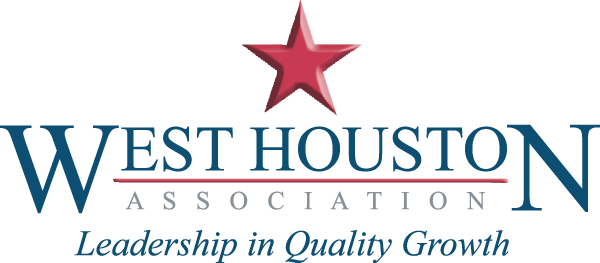On July 28th the West Houston Association hosted a half-day series of panels each dedicated to the theme of ‘Collaborating for Quality Growth.’ Through a collaboration with Houston Community College and the support of WHA’s Quality Growth Partners, the event was held at the West Houston Institute and free to attend.
The event began with discussing two different quality planned developments in the region and the success they’ve experienced over the past twenty plus years. Then, the conversation turned to the issue of lot sizes and market demands to reveal exactly what works and what doesn’t. The series ended with a talk about attracting the commercial businesses that developing communities want. The silver thread throughout each conversation was about the power of collaboration in shaping a sustainable and prosperous future for our communities.
Alan Steinberg, President/CEO of the West Houston Association emceed the event. He set the stage with a bit of idealism by saying, “Today, we embark on a journey of exploration, innovation, and partnership, where we come together to unlock the secrets to achieving high-quality development that you would be proud to have in your community. Throughout this event, we will hear from visionary leaders, industry experts, and community stakeholders who have harnessed the power of collaboration to drive quality growth in land development.”
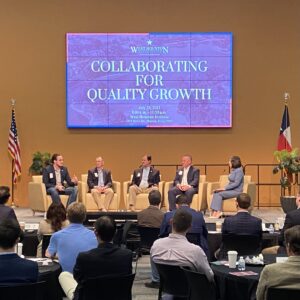 The first panel, “Success Stories of Quality Development in Rural Communities,” consisted of two pairs of panelists with two stories of success to tell. Brett Walker, President of Parkside Capital and Byron Hebert, City Administrator, City of Katy, who told the story of commercial development over the past few decades in Katy. Russell Bynum, General Manger, Hillwood Communities, and Dan Davis, Jr., Mayor, City of Manvel, spoke about the present-day residential development by Hillwood in the Manvel area. Alia Vinson, WHA Board Member and Partner with Allen Boone Humphries Robinson served as moderator for the panel, weaving together the stories to provide a holistic picture of development in rural communities.
The first panel, “Success Stories of Quality Development in Rural Communities,” consisted of two pairs of panelists with two stories of success to tell. Brett Walker, President of Parkside Capital and Byron Hebert, City Administrator, City of Katy, who told the story of commercial development over the past few decades in Katy. Russell Bynum, General Manger, Hillwood Communities, and Dan Davis, Jr., Mayor, City of Manvel, spoke about the present-day residential development by Hillwood in the Manvel area. Alia Vinson, WHA Board Member and Partner with Allen Boone Humphries Robinson served as moderator for the panel, weaving together the stories to provide a holistic picture of development in rural communities.
Brett and Russ kicked us off by providing some background on their projects in their respective areas. In talking about the city’s role in development and what’s necessary to have a positive relationship with developers, Mayor Davis highlighted that “the city’s role in development is not meant to be burdensome – it’s to ensure we’ve fulfilled the fiduciary responsibility to the taxpayers.” He stressed that the City of Manvel holds regular conversations with Hillwood Communities so that they can collaborate on development and end up with a product that all are proud of. “Your city can’t grow without developers,” said Administrator Hebert, “developers know the pulse of what’s happening” and are a key component to making sure your city is a success.
It is no secret that development is finding its way to many outlying cities on Houston’s existing sprawl. Developers are approaching communities with lessons learned and a mindset of collaboration to create those necessary partnerships between public and private sectors. Russ Bynum pointed out, “One of the things we started out with Pomona was doing a charrette. Inviting the stakeholders and making sure that we not only heard them but gave them an opportunity to decide what was going to happen with that community.” He also noted the importance of being engaged with the community more broadly. This approach is recommended for any positive developer-community relationship to flourish. Walker echoed similar sentiments regarding the relationship with the City of Katy and highlighted the importance of working with local experts and consultant partners. In thinking about advice for developers looking to work in these types of communities, Vinson stressed the importance of building trust as these relationships often last for years, as well as always keeping the perspective of the community and its residents in mind.
In talking about the challenges of working through multiple layers of government, Walker addressed the three-and-a-half-year process of getting the Cane Island Parkway constructed, including the overpass of I-10. It started with the developer putting out over a million dollars, followed by exchanges over multiple counties, TxDOT, the city, and the Federal Highway Administration. Hebert followed up by expressing his appreciation towards Parkside Capital for getting this project done. Shortly after completion of this project, Katy saw it’s first Buc-ee’s go in on the corner of I-10 and Cane Island Parkway, raking in major economic development value for the region. Bynum mentioned a similar experience during development in Manvel – working with TxDOT and the City of Manvel, through strategic partnership agreements, getting some of the tax value from a community outside of the corporate limits.
The conversation of lot size arose across all three panels. In the first panel, Hebert gave a brief history of this topic within the City of Katy: “Back in the day, City of Katy, you had to have large lots. Then we started opening our thought process to smaller lots.” Mayor Davis pointed out that as communities evolve and transform, one of the key considerations is the strain on current community resources like streets, water, fire, police. “It’s about keeping an open mind. It’s understanding that you can have mixes [of lot sizes].” A question to think about is, “How is what is being built fit into the existing culture of the city?”
The second panel, “Understanding Market Share and Lot Size Ratio,” explored this topic in more depth. This panel, moderated by June Tang, Vice President and General Manager with Johnson 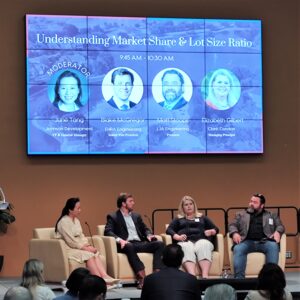 Development, included Blake McGregor, Senior Vice President, EHRA Engineering, Matt Stoops, Planning Director, LJA Engineering, and Elizabeth Gilbert, Managing Principal, Clark Condon. They dissected the vital role market share plays in decision-making for developers, investors, and homeowners touching upon the impact of lot size on affordability, sustainability, and urban planning.
Development, included Blake McGregor, Senior Vice President, EHRA Engineering, Matt Stoops, Planning Director, LJA Engineering, and Elizabeth Gilbert, Managing Principal, Clark Condon. They dissected the vital role market share plays in decision-making for developers, investors, and homeowners touching upon the impact of lot size on affordability, sustainability, and urban planning.
Tang kicked off the panel by discussing what developers do, how they plan for space, building the infrastructure, subdividing the land, and of course, bringing value. McGregor and Stoops both pointed out that value and lot size are not as connected as people may think! A larger house might not be higher quality, and lower quality houses on larger lots don’t lead to more tax value for the community. Meanwhile, there are people who want a lower maintenance lifestyle – smaller lot and a smaller house – and would rather spend their money on quality components and more neighborhood amenities. As Stoops pointed out, smaller lots with more community space can actually “bind a community together.”
Gilbert carried on the conversation of amenities and community spaces by adding that trails are the most requested amenity right now and there is a large demand for health and fitness related opportunities. Reinforcing her statement, Gilbert brought to light the correlation between less healthy communities and lack of green spaces. Furthermore, she said there is more and more of a push for no-mow landscapes and more naturalized landscapes that both assist in the community’s sustainability and connect residents to a great environment. People are often not ‘just choosing a house’, but rather, choosing the community too. “We are creating a home for a person,” said Gilbert.
While planners have ideas on what to do and cities have ideas about what they want, “market studies tell us what is possible,” said Stoops. Additionally, the market can change as development is happening – especially with larger developments that are longer-term projects. Over time, developments are working to create a sense of place that connects to the history of existing communities. Gilbert emphasized the connection between what exists and what is being developed saying, we are “trying to make it a very authentic place that people can connect with.” Of course, this will lead to gradual changes that impact the desires of community members. As the community grows and fills out, its vision for the future will change. McGregor stressed the importance of development working together with the community as growth happens, especially to address engineering challenges. This echoed some of the sentiments from the first panel – when you partner with the right people up front and throughout development, taking the time to think things through and do them right the first time, you see better outcomes for all.
The third panel focused on the nexus of “Development, Growth, and the Workforce,” with Shaun Theriot-Smith, Senior Real Estate Manger with H-E-B, and Jay Sears, Owner of NewQuest Properties and moderated by Loren Morales, Director of Municipal Finance with RBC Capital Markets.
Morales started the panel with a brief overview of development financing and municipal utility districts. To summarize their value, he says, “In the long run, it leads to the development of new funds and a broader tax base for the community.” He also discussed how M.U.D.s are more than just residential, but also for commercial development. This then opened the dialogue to allow Theriot-Smith and Sears to chat about their developments in the greater West Houston region.
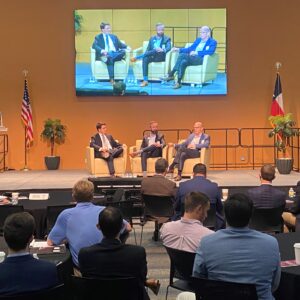 Morales then posed the question many people in the room were waiting for, “What do you [H-E-B] look for when making the decision to invest in a community, and what can a city do to help encourage development and economic conditions in their markets to make it viable for a new store?” Of course, there is the adage, “retail follows rooftops,” but Theriot-Smith shared how it also relates to density, demographics, and a development that will be established for decades to come. H-E-B seeks a long-term relationship with communities and plans each store carefully with sustainability of operations in mind. He also stressed working with the community to understand the long-term plans for infrastructure such as transportation to get to and from the store, so there is a desire to ensure the community is ready before coming in.
Morales then posed the question many people in the room were waiting for, “What do you [H-E-B] look for when making the decision to invest in a community, and what can a city do to help encourage development and economic conditions in their markets to make it viable for a new store?” Of course, there is the adage, “retail follows rooftops,” but Theriot-Smith shared how it also relates to density, demographics, and a development that will be established for decades to come. H-E-B seeks a long-term relationship with communities and plans each store carefully with sustainability of operations in mind. He also stressed working with the community to understand the long-term plans for infrastructure such as transportation to get to and from the store, so there is a desire to ensure the community is ready before coming in.
This panel drew connections with the first panel when Sears discussed the history of development in Katy – including successes and missed opportunities that he faced in that community over the last forty years. Sears focused on the opportunity to develop the intersection of 99 and I-10, which he feels will “be significant for many many years to come and will ultimately be the center” of the region.
Morales connected this panel with the second panel when he asked about the impact of schools on development. Theriot-Smith discussed how they take the school district into consideration when making an investment, even following what’s happening with school bond elections. “We employ 300-400 people per store. We want to see diversity of housing to sustain the workforce and school districts.” Sears added on by noting that “the number one challenge for retail right now is finding employees.” He stressed that multi-family housing is essential to have a thriving community.
To round out the panel discussion, Morales moved to the relationships between the city and the commercial development. Sears stressed that “the city should be inquisitive.” Ask about the developer’s experience, what the development will do for the community, and what will be the long-term impact. A tough conversation to have between the developer and community is when the city has wants that are less than realistic based on current conditions. Sears’ advice to a city is this: “If someone comes in an says, ‘we are going to build Disneyland,’ you need to listen and then say, ‘show me.’”
As the event ended, Steinberg encouraged attendees to reflect on the insights shared and connect with others in the room. He left the audience with his own reflection on the event that “the discussions have illuminated the significance of working hand in hand, pooling our expertise, and fostering partnerships across sectors to achieve transformative results.”
The West Houston Association would like to, again, thank our Quality Growth Partners for their year-round support which allows us to bring people together at events like these, share ideas, and continue to shape the quality of growth in our region together.
